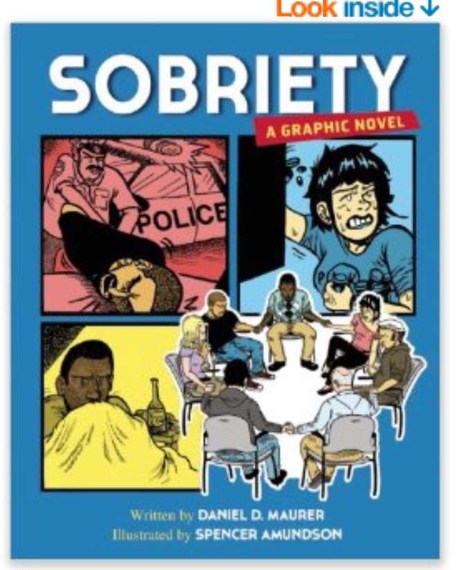Have you struggled with an addiction to alcohol, food, ecstasy, meth or Xanax? If so, you are like millions of others for whom the new book Sobriety: a Graphic Novel was written -- or actually drawn. Anyone who likes graphic novels will be engrossed in Sobriety's drawings, storyline, dramatic tension and characters -- who are as varied as an African-American man from the UK, a high school girl adopted from Vietnam and a former factory worker pushing 70. But those who have found themselves unemployed, couch surfing, arrested or sick from addiction will especially see themselves in Sobriety's pages.
Debby's addiction to benzos and alcohol lands her in a psych ward after she threatens to kill her parents if they take her two young sons -- and tries to slash her wrists with a ballpoint pen. Matt ends up arrested after joining a Latin gang to avenge the death of his father who was also in a gang. Hannah only escapes death from a heroin overdose because someone -- she will never know who! -- gives her a naloxone shot.
Sobriety mostly takes place during one afternoon in a treatment facility. Five addicts share their "using" stories and emotions about their arduous journeys through flashbacks and sometimes flash forwards into comic book-style fantasies. Though the addicts have divergent substances of choice, "using" histories and spiritual and sexual orientations, they are able to help each other through the Twelve Steps of anonymous programs which stress focusing on similarities and not differences.
For example, when one addict admits that he has lied about part of his story, another says that lying is part of the "disease" they share and that it is to be expected. It is a shame-free zone. When another addict tells a newcomer that he has to believe in God to be able to work the Steps and achieve recovery, the other addicts quickly correct her. A higher power is not the same as "God," says the group. It is a personal construct of anything that is "greater" than oneself, including an Twelve Step group itself which has sometimes been called Group of Drunks. Atheists are welcome.
Another addict violates "anonymity" by telling a part of someone else's story that she heard but was never supposed to repeat. It violates a Twelve Step dictum that says "Who You See Here What You Hear Here, When You Leave Here, Let it Stay Here."
In both missteps, Sobriety shows the power of the "amend" -- a swift apology when someone has done something wrong. Both the apologizer and the recipient of the apology are able to release guilt and resentment, respectively, and move ahead in their recovery with a clean slate.
Finally, Sobriety shows the power of community in helping addicts and alcoholics heal. Bonds are formed by identifying with one another's moment of "surrender" (in which the addict accepts help) whether he was in a crack house or penthouse when it happened. Sponsorship -- old-timers showing newcomers the ropes -- helps not only people who are newly sober or straight but the sponsors themselves who are able to renew their gratitude and perspective.
Written by Daniel D. Maurer, a former Lutheran minister, and illustrated by Spencer Amundson, Sobriety seems like a kind of X-rated Archie and the Gang. The problems are different, the solutions are different, the pranks are way different but the group always finds a way through with camaraderie.
ISBN-13: 9781616495572
Publisher: Hazelden Publishing
Publication date: 11/4/2014
Pages: 150
